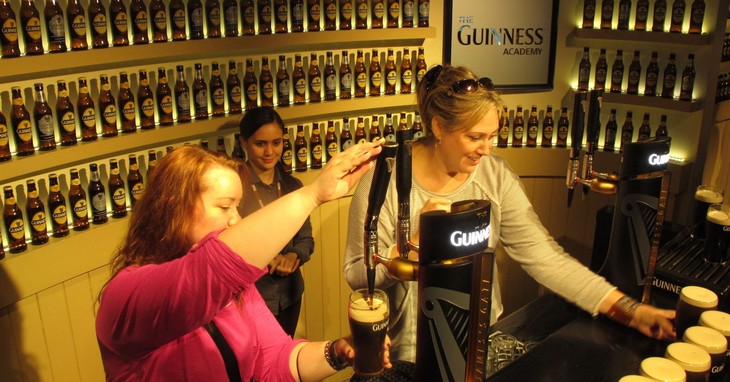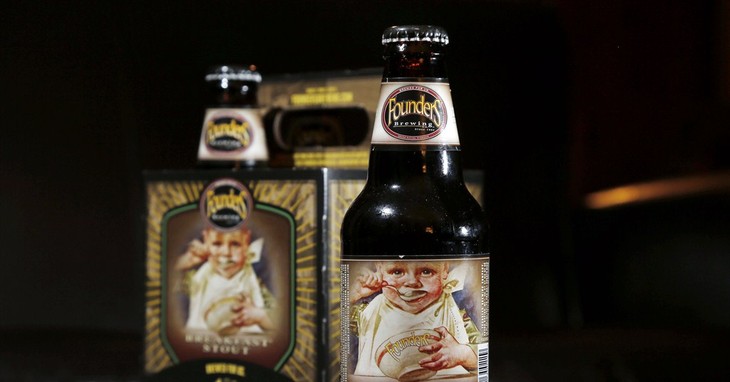From flavored porters to milk stouts, there are many options to ease yourself off of the standard of the style.
The color palette of beer, while not as varied as the flavor palate, is impressively wide. Starting with lemonade-hued session beers you can encounter, golds, tans, browns, reds, and differing levels of clarity therein, all the way to the eclipse-colored dark beers. We will be focusing on those opaque offerings, and do so by getting the most popular out of the way first.
Guinness is the most recognized brand of stout worldwide, and it is not even close. Sold in over 125 countries and brewed in 50 of them, the original brewery is over 250 years old. While not necessarily elitist, drinkers of Guinness can still be a passionate lot. They will tout the richness, and point out the magic of the reversed head of foam — this being an optical illusion. When the Guinness draft is dispensed with nitrogen it creates the velvety foam head it is known for, the result of much finer bubbles that create the unique visual. What you are seeing is the liquid moving down through the head, made more visible by the lighter foam and darker beer.
Many Guinness drinkers cling to their rich malt elixir with a rock-ribbed devotion, touting its benefits over many other beers, even as they declare that some people cannot handle the heft, the taste, or the strength of Guinness. The only problem? Better, more potent, and flavorful choices abound, especially in the side category frequently seen with bovines on the packaging. To get there we have some lengthy history to carve through.

The King That Is Actually A Lightweight
Those adherents of the beer who attribute to it its elevated stature and character are not operating with all the facts. As Guinness is renowned as an Irish product, the beer itself originates from London. The style of porter came into existence in the early 1700s, springing from the use of different malts and roasting methods which created a dark brew. It held an appeal to brewers, as it was cheaper to make, could be made in larger batches, and it held up very well against spoilage. This stronger brew, sometimes called “2-penny” after its cost per pint, appealed to the working class in London, especially the dock workers, and it then adopted its name from those laborers with whom it was so popular.
Stout, meanwhile had long been the term used to indicate strength. Porters were next being made with different alcohol strengths, usually ranging from 6% ABV to over 9%. Those higher potency versions were referred to as stout porter, then as the centuries and wars developed, and recipes continued to be altered, stout took on more of a property and style definition than one of strength, to the point now that stout and porter are basically interchangeable. This is seen today in the product so many imbibe.
Over the course of decades, two world wars had an effect on the beers. Rationing of the base ingredients and the taxation on beers based on alcohol strength saw many changes to the brewing. Guinness scaled back its potency to a 4% level; today, it stands near this strength, at 4.2%, which ironically means that Guinness Irish Stout is about half as strong as the porters which originally took on the stout designation. This means those high-minded proclamations are used to describe what is a weaker version of a blue-collar brew.
From my samplings of Guinness, I’ve always felt this legendary beer was actually wan in flavor, mostly chalky and notably lightweight. In fact, many porters offer up more complex profiles.

Break From The Pack And Follow The Herd
For a time, the porters and stouts fell out of favor in the marketplace, but by the 1970s, the birth of what became the craft beer industry saw intrepid brewers returning to this classic style. Today a dark stout or porter is almost a required portion of any brewer’s label portfolio, with myriad flavors to be found. Common traits adding to the strong malt flavor base are rich grains, toasted elements, along with chocolates, coffees, and even sweeter components like caramel.
Fitting into this is a sub-class of these beers which I routinely seek out. For overall pleasure from a full-bodied brew, I always trend towards the group known as milk stout. While Guinness makes promises, milk stout delivers. This style emerged in the early 1900s, when some brewers began experimenting with lactose, a by-product of the cheese industry. Adding lactose to the beer created not only a different brew, but a completely new flavor profile.
It also offered brewers a marketing ploy. Many labels advertised the health benefits of their beer, equating it to be on par with a glass of milk. Over time, the British Government stepped in and banned any reference to the beer having milk qualities, given that these bold claims were all being made about sugar. These restrictions led to the milk stout style gradually receding from the British marketplace, but it has stampeded back in America’s craft breweries.
The milk stout market has really expanded in recent decades here in the United States, with craft brewers adopting the method and taking it to new pastures (so to speak). These beers are notable in all the areas where Guinness is lacking. They’re fuller in body, broader in range of flavor, and almost always more potent. (A 6% ABV is rather common.)
The heavier body and sweetness found in milk stouts work as a post-meal beer, and the sweetness teams with desserts. The flavors also hold up better alongside cigars, serving as a counterpoint and keeping up with those sharp flavors. There are a number of the larger craft brewers across the country where you can get this style in solid quality. Left Hand Milk Stout, coming out of Colorado, is a dependable and sometimes complex offering. You’ll get distinct sweetness and a rich roasted taste, with cocoa detectable as well. The Left Hand Brewing Company has also produced a Nitro version, both on draft and in bottles, to give the similar Guinness head effect.

Founders has an Oatmeal Milk stout that has to be tried, lending another variation on the style. Southern Tier has their amazing double-milk stout which is a flavor bomb that will have you studying what is washing across your tongue. If you are in the Midwest, you need to look for Lugene Chocolate Milk Stout. This one’s named after a local dairy farmer the Odell Brewing Company has worked with for years.
Then taking things to all-new levels in this style is New Holland Brewing. After beginning with its signature Dragon’s Milk, aged in bourbon barrels and rolling in with an 11% kick, it has expanded this line with 5 different styles and also a rotating lineup of seasonal flavors of its flagship label.
These might make you forget all about that Irish lightweight you used to drink.















